
Recording Adventures...
Another personal odyssey [1970-
Recently I realised that the home page of this site says “an English musician who builds and designs his own synthesisers and recording equipment” yet, so far, there has been no mention of recording equipment. So for completeness and for anyone who might be interested in my story of recording on home designed and built recording equipment I’ve added this page.
I’d been interested in tape recorders since I was very young. My father bought me (more like bought both of us) a simple domestic valve based tape recorder, based on a BSR deck, when I was a child. This started it all off. I soon got interested in how they worked and the art of recording. I also soon learnt that professional studio tape recorders however were in a different world, running much higher tape speeds and wider tracks and... were very expensive. One early band I was in borrowed a Ferrograph tape machine to record rehearsals on. This was a really good quality semi-pro machine so I really started to want one. Fortunately I then discovered in “Wireless World” magazine a series of articles on building a hi-fi tape recorder. From the gig money I saved up and bought a Brenell tape deck that would run at the necessary 15”/second for good quality. Here was a chance to own an affordable good quality recorder which I hoped would match the Ferrograph. I sourced the tape heads in the article which I think were made by Bogen. The result was my first good quality recorder.
Pictured opposite with the tape head covers off, it worked well although the deck was a little clunky. The design used integrated circuits which were fairly new at the time. I also remember winding ferrite-core transformers and coils for it and having trouble matching up the components. Sound-on-sound was possible with it which was a revelation if rather hissy after a few transfers. I recorded music, my guitar playing & overdubbing it, friend’s performances and later recorded experiments with the first synthesiser I built.
What I needed though to get serious was a multi-track tape machine of 4 tracks minimum. The opportunity came along at the end of the seventies when an old faulty Brenell recorder was being thrown out by the company I was working for. The electronics were valve and completely shot but the deck looked salvageable. I found a source of 1/4” 4 track heads that were just affordable so I decided to have a go. I’d learned a lot about the workings of tape recorders over the years so I decided to design a four track. It was a bit of a struggle but eventually I built a good working model. With this and the 2 track above acting as master tape, I had a studio!! I recorded the “Out of Control” rehearsal tapes and my first album “Where Dark Forces Meet” on it.
Just like I did with my synthesisers, after this experience I started to think bigger. I spotted an ad in a magazine from a kind of radio shack/audio equipment breaker in Leeds. It said they had some old tape decks in stock. I travelled over to see them and found they had some wonderful stuff from EMI valve antiques to various studio workhorses. I really wanted to take all this classic stuff home! However some really solid looking Philips decks caught my eye. The model was EL3503 and he had 150 of them in various states of repair! I learnt that most of this stuff was ex BBC, thrown out in favour of the latest models. I bought 2 Philips ones for a very reasonable sum. One worked and one had fault that I fixed. They were amazingly solid. I liked these decks and it looked like running 1/2” tape might just be possible. First though I refurbished one and made a 2 track based on the old 4 track design with improvements. It worked really well. See picture opposite (machine on the right of the two). This machine served me really well over the years.
After the 2 track success I took the tape guides from the other Philips deck to a local engineering company and they opened them out for me... amazingly for free! The 1/2” four track heads I bought from Branch and Appleby who made them to exactly fit the head carrier on the deck. These things though were expensive. To help pay for them I sold the old 4 track.
The then new 1/2” four-track recorder is pictured above (machine on left) and you can see underneath the 4 Dolby “B” units which I transferred to it from the old 4 track, to reduce tape hiss a bit. With these in circuit the noise performance at 15”/sec was really pretty good. With this 4 track I recorded several of my later albums. I also later added an old Dolby 301 noise reduction unit, under the 2 track, for mastering . The 301 is an early modular style professional Dolby “A” unit. It is a very good unit if rather bulky.
I wasn’t however finished yet. A lot of my music contains atmospheric sounds and effects that I fly in to the mix. Most don’t need to be in perfect sync. so just by adding more 2 track recorders I figured could add more tracks to my mixes cheaply without having to constantly overdub. So I eventually bought 4 more Philips decks and built them as playback only machines. I had two finished when the photo opposite was taken. As you can see I was still using the old Brenell machine too. Around that time I learned the local community centre, due to alterations, were throwing out 2 old tape machines found in a store room. I was offered them. They were small reel Philips Pro 12 model shown opposite. One had problems but the other got used quite a bit for the odd sound effect and it was good for slowing stuff down as it could run at 3 3/4”/sec.They were very good solid machines. This was all great but...
The first 2 track recorder (left) and the first 4 track recorder (right). (Roll mouse over for bigger view).
The next generation of recorders.
The playback machines.
Philips Pro 12 machine.
There was a growing problem with this cheapo approach to multi-tracks; stopping and starting the recorders to run in the various sounds at the right time was a real headache. I needed some form of automated remote control. This came along in the form of a BBC micro, remember them? You can see it in the picture opposite just by above my right hand. By this time I had an Atari, remember them too? The BBC’s screen is the lower one under the Atari monitor. I rigged up a relay box operated from a simple tape start, stop recorder program I’d written partially in assembler and partially in basic for the BBC micro. The screen shows the first 3 tapes running. With this program I could start and stop nearly all my tape machines from the BBC’s keyboard and record on the fly and edit the results, saving the takes to floppy disk.
I kept this arrangement until I eventually gradually switched over to using a PC and multi-track software to record and edit everything.
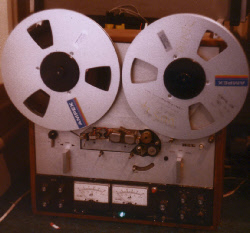
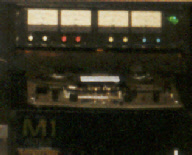
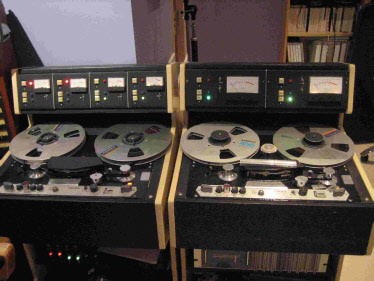
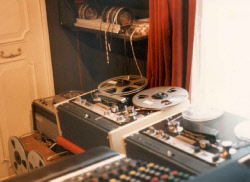
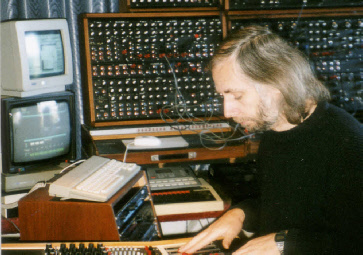
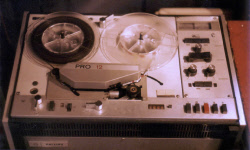
| Home |